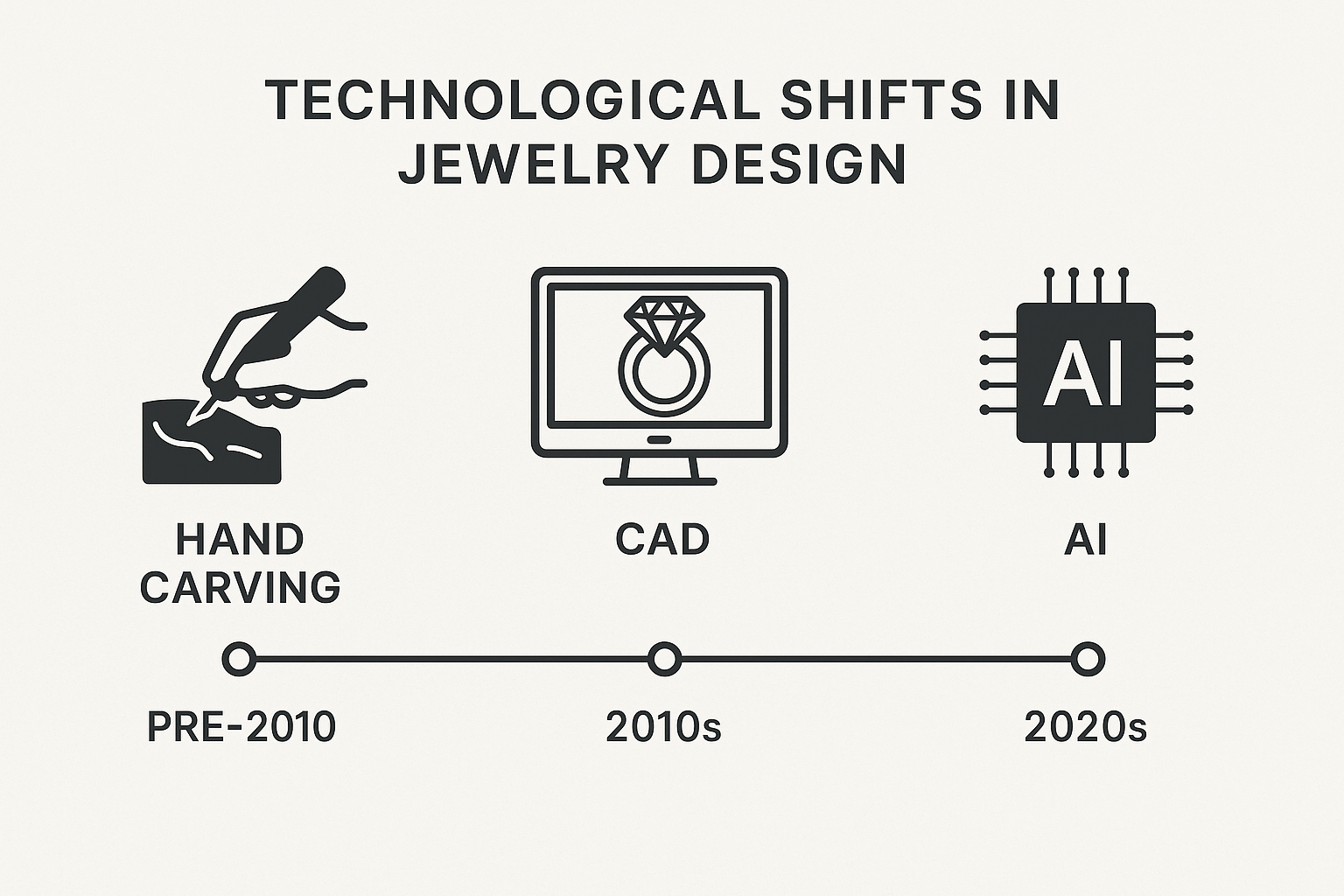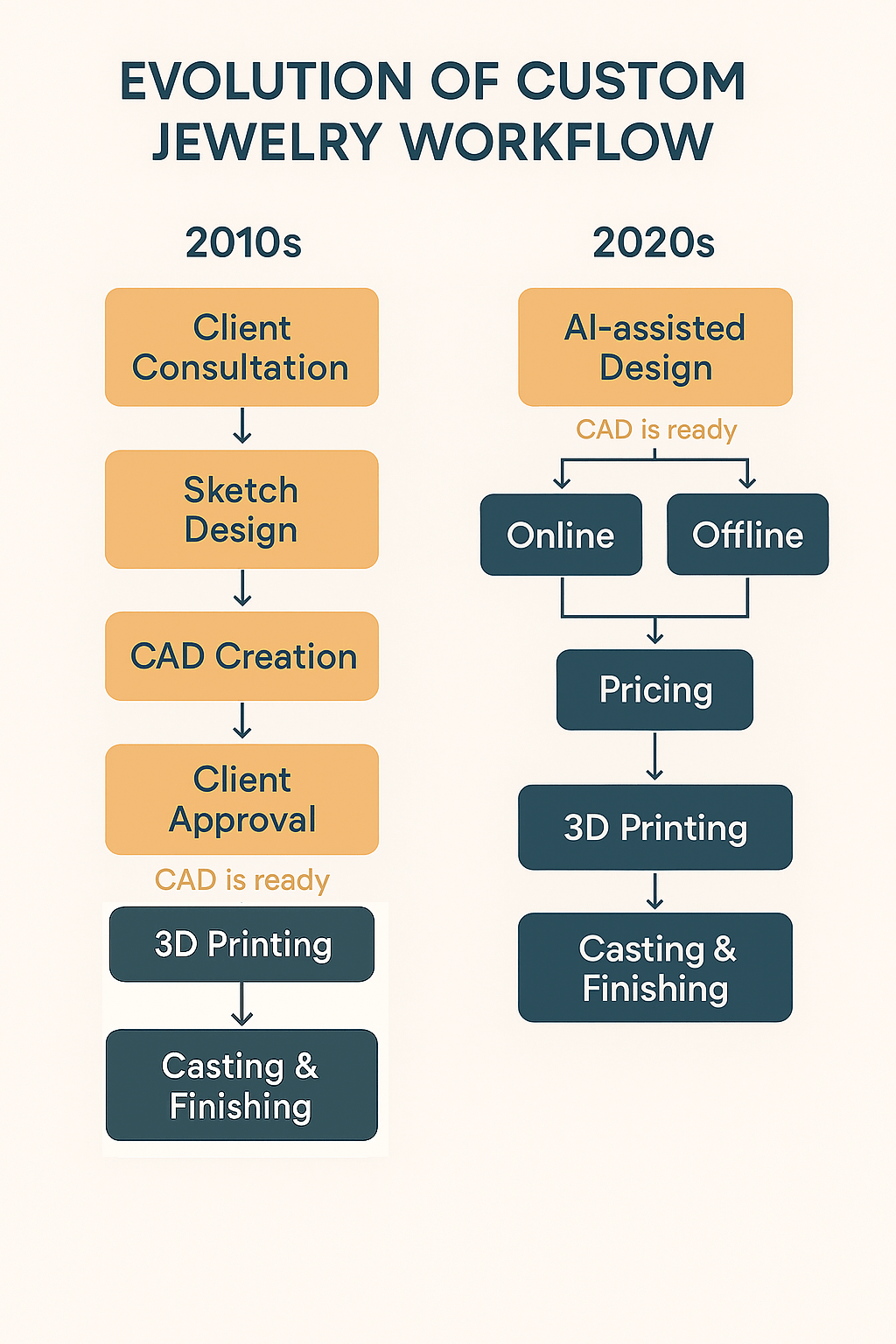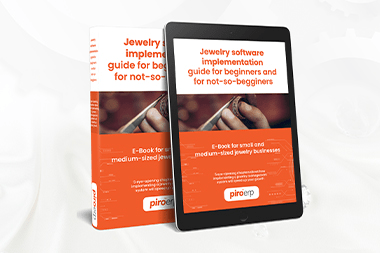I’ll admit - we’re barely keeping up ourselves. Every week, a new AI tool emerges that either speeds up our workflow or completely changes the way we do things.
There are still many unknowns about how AI will transform jewelry companies, but I already have a vision in mind - and we’re closer to it than most people would guess.
If this vision comes true, it will radically reshape how jewelry businesses function today.
The CAD/3D printing revolution: A Case Study in disruption
If you had to guess, what recent technological breakthrough has already changed the way jewelry companies operate?
My vote would go to 3D printing. With the rise of CAD and 3D printing, three major changes occurred:
- A whole profession - the hand wax carver - virtually disappeared. Between 2010 and 2015, CAD became fully accepted and widespread.
- CAD and 3D printing enabled designs that were previously unimaginable or extremely difficult to produce - revolutionizing the design process itself.
- Customers could now see a photorealistic image and 3D view of their jewelry before it was ever made. This later became a cornerstone of how we sell jewelry online.
So - are you ready for the next big shift?

I believe that AI-powered tools will offer design capabilities that the demand side of the market will very quickly adopt and embrace.
How AI design tools will disrupt today’s custom jewelry workflow
But before I get into the details of my vision, let’s look at a few current assumptions:
- There’s a high demand for personalized, custom jewelry. That’s why everyone - from traditional retailers to online platforms - has focused on it. Just look at the rise of online jewelry configurators.
- The process of creating custom jewelry is time-consuming, from concept to final design. It often requires multiple rounds of consultation and approvals.
- An expert was traditionally needed to not only interpret what the customer wanted but also to provide a tailored price based on the design and production costs.
This entire process is about to be disrupted by the new wave of generative AI tools.
How generative AI changes the Game
The demand for personalized jewelry isn’t going away - but tools like BLNG AI, RhinoArtisan, and Gemist are set to transform the buying experience dramatically.
Here is what Julie Henley, partner at Entrada Ventures - seed investor of Gemist - said:
“Today’s consumers demand personalization, transparency, and beautiful digital experiences. Gemist delivers all three, empowering the jewelry industry to grow without adding operational complexity.” Source
What exactly do I predict with the rise of AI-assisted custom design?
- No more lengthy back-and-forth consultations to finalize a design. Customers will be able to do this themselves – online - guided by prompts or voice-based instructions.
![Future of jewelry design with AI tools and automation]()
- Instant virtual try-on will become mainstream. The tech has existed for a while, but it will truly take off when customers can try on their custom design immediately after creating it, using photorealistic renders.
- AI design tools will replace expensive, rigid configurators, offering dynamic experiences that adapt based on customer behavior - helping users co-create the perfect design.
- For those who still prefer in-store consultations, a full 3D model can be created by the end of the conversation.
- There will no longer be a need for an expert to calculate custom jewelry costs and pricing. This can be done automatically via API integrations and pricing algorithms, which also factor in each company's profit margins.
- Language-based AI systems will support customer education, empowering buyers to make smarter decisions. Consumer behavior will shift drastically - they’ll be hyper-optimized about what they spend money on.
- For example: once people realize they can request a lab-grown diamond with the same specs as a natural one, most will choose the former.
- Generative AI could also encourage more sustainable practices. By optimizing material use, reducing production waste, and encouraging lab-grown alternatives, AI could lower the industry's environmental footprint.
- For example: once people realize they can request a lab-grown diamond with the same specs as a natural one, most will choose the former.
- We may even see the rise of full-scale jewelry manufacturers who accept direct orders from customers, weakening the role of retailers and wholesalers. Today, retailers still act as essential experts in the value chain - but soon, they may no longer be irreplaceable.
Mini Case Study
Imagine James, who wants a unique engagement ring. He uploads a sketch and describes his preferences using voice prompts. Within seconds, an AI tool generates several 3D options. He virtually simulates a try-on, adjusts the band width, and picks a lab-grown diamond - all before lunch. The system shows the final estimated price, confirms delivery in 12 days, and emails him a photorealistic render. No back-and-forth. No uncertainty.
What Retailers and Designers must do now
As with any disruption, there will be winners and losers. The key is to act early.
But one thing is certain: the jewelry industry won’t be immune to the technological shifts brought by AI - shifts that will radically transform customer behavior.
And in this race, those who adapt first to changes in customer behavior will be the ones who thrive.
Remember? Not that long ago, Steve Jobs’ vision completely reshaped consumer behavior in a different segment. So drastically, in fact, that giants like Nokia, Blackberry, and Alcatel plummeted almost overnight. Today’s younger generation barely even knows who they were.
Of course, mass AI adoption will raise new questions around data privacy, IP ownership, and creative authorship. But as with every wave of innovation, early adopters will help define the standards.
So here’s my final piece of advice:
Think digitally. Utilize an automated jewelry ERP system to drive an AI-powered customer experience. AI enhancements in jewelry software are coming.
That’s how you stay ahead of the curve.
FAQ: The Future of AI-Assisted Custom Jewelry Design
- How is AI changing the future of custom jewelry design?
AI is changing the future of custom jewelry design by generating unique concepts, analyzing consumer style preferences, and speeding up the creative process. This allows jewelers to deliver personalized pieces more efficiently. - What benefits do customers gain from AI-assisted jewelry design?
Customers benefit from AI-assisted jewelry design through faster design iterations, realistic 3D previews, and more personalized options. This creates a more engaging and satisfying buying experience. - How will AI impact the role of jewelry designers?
AI will not replace jewelry designers but will serve as a powerful creative partner. Designers can leverage AI for inspiration, automation of routine tasks, and idea generation while still applying their craftsmanship and artistic vision. - Can AI-generated jewelry designs be manufactured successfully?
Yes. AI-generated jewelry designs can be manufactured when refined with CAD/CAM tools and validated against production requirements. The combination of AI innovation and CAD precision ensures manufacturability. - How is PIRO preparing to integrate AI trends into jewelry business management?
PIRO is preparing to integrate AI trends by exploring ways to connect AI-generated jewelry designs with inventory, manufacturing, and sales workflows. This ensures jewelers can adopt AI tools without disrupting their existing business processes.







